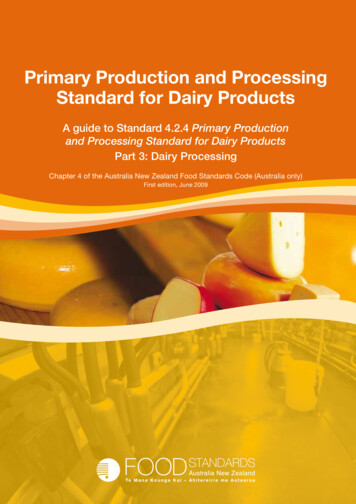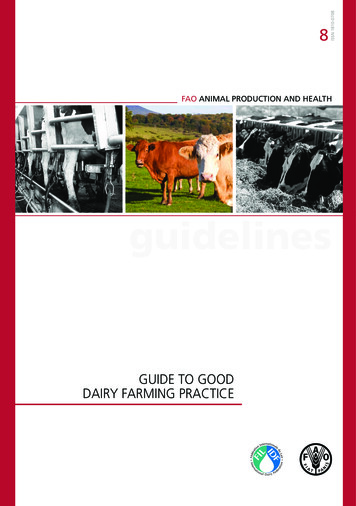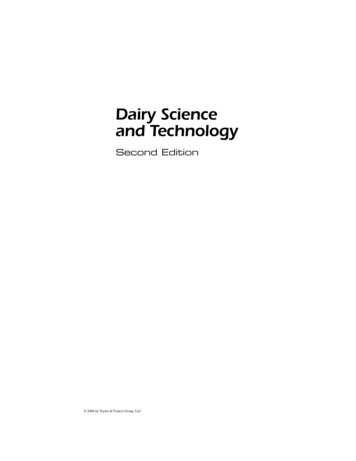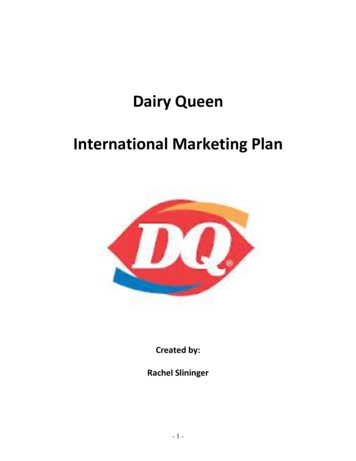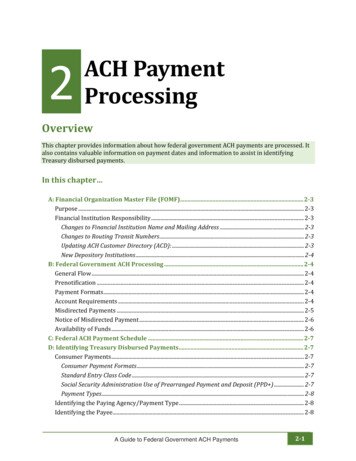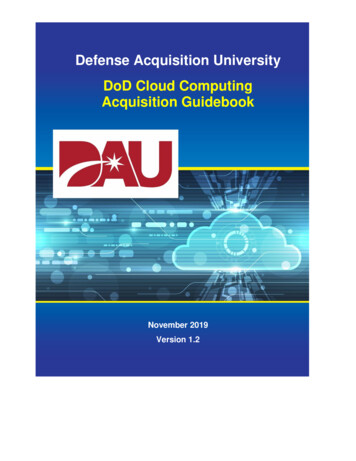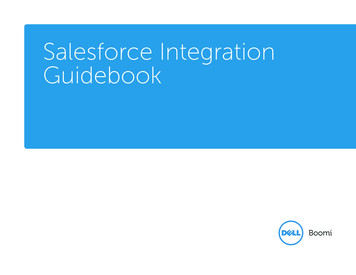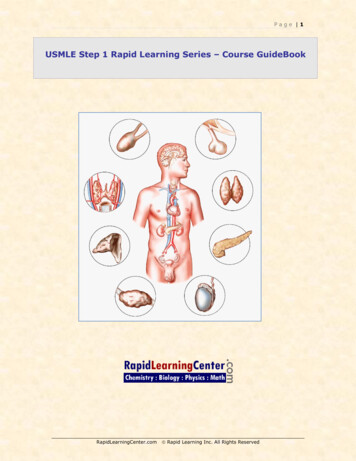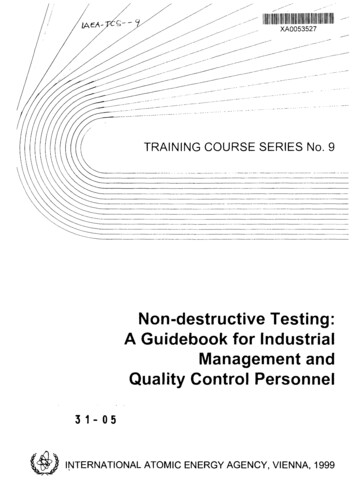
Transcription
DAIRY PROCESSING INDUSTRYENERGY BEST PRACTICEGUIDEBOOK
Dairy ProcessingEnergy Best Practice GuidebookProvided By:Funding for this guidebook was provided by Focus on Energy.Focus on Energy, a statewide service, works with eligible Wisconsin residents and businesses toinstall cost-effective energy efficiency and renewable energy projects. We provide technicalexpertise, training and financial incentives to help implement innovative energy managementprojects. We place emphasis on helping implement projects that otherwise would not getcompleted, or to complete projects sooner than scheduled. Our efforts help Wisconsin residentsand businesses manage rising energy costs, protect our environment and control the state’sgrowing demand for electricity and natural gas.With:Science Applications International CorporationEnViseGDS AssociatesCleanTech Partners, Inc.Industrial Refrigeration CenterUniversity of Wisconsin-Biological Systems EngineeringJuly, 2006Focus on Energy 20061
TABLE OF CONTENTSFORWARD . 3Are you a World Class Energy Consumer? . 3What Others are Saying about the Guidebook . 3Executive Summary . 4INTRODUCTION. 5Development of the Guidebook. 5MANAGEMENT BEST PRACTICES . 6Steps to Getting Started . . 7Steps for On-going Energy Management. 13TECHNICAL BEST PRACTICES . 14Introduction . 14List of Technical Best Practices. 15Refrigeration Best Practice Summaries. 16Whey Drying Best Practice Summaries. 36Concentration Best Practice Summary (1) . 38Steam System Best Practice Summaries . 41Process Heat Best Practice Summaries (1) . 45General Best Practice Summaries. 48APPENDICESAppendix A:Appendix B:Appendix C:Appendix D:Appendix E:Appendix F:Appendix G:Best Practices Summary Checklist . . 52Best Practices for Common Systems. 53Refrigeration Energy Efficiency Potential Checklist. 55Dairy Processing Team Contact Information. 62Understanding Your Utility Bills and Use Patterns . 63Additional Resources . 67Acknowledgements . 71Focus on Energy 20062
FORWARDAre You A World Class Energy Consumer?World class energy users have:1. Benchmarked energy consumption in their dairy processing facility2. Defined quantifiable, affordable energy reduction goals3. Established a multi-year plan to meet their energy reduction goals4. Assigned a cross-functional team to implement the plan5. Reporting, feedback and renewal process6. Obtained firm commitments from their facility manager for improvements in energyefficiency and demand reductionIf your dairy processing facility lacks any of these essential ingredients, this best practiceguidebook will help you get there.What Others are Saying about the Guidebook:John Umhoefer, Executive Director, Wisconsin Cheesemakers Association"Rising energy prices continue to be a concern for our industry. This guidebookprovides several ideas that will help reduce energy costs for our members."Nick George, Executive Director, Midwest Food Processors Association"The Best Practices Guidebook is a great tool to help energy practitioners make animmediate impact on conservation and efficiency. That is critical to our industry'scompetitiveness in an era of rapidly increasing energy prices."Jim Cisler, GROW Wisconsin Dairy Lead, Department of Agriculture, Trade and ConsumerProtection“With today's rapidly rising energy costs, this is great information every dairyprocessing facility manager will want to put to use to improve the bottom line."Focus on Energy 20063
Executive SummaryThe objective of this Dairy Processing Energy Best Practice Guidebook is to provide resources andmethods to reduce energy use and energy related costs in dairy processing facilities. Using thisguidebook, dairy processing facility managers will learn how to manage energy in their facility anduncover opportunities to significantly reduce facility energy consumption.Contents include: Guidelines and tools for energy management best practicesAverage energy use for typical dairy processing facilitiesDescription of over 20 best practices for process energy use and other bestpractices for common system energy useBest practice funding and financing opportunitiesReferences for further opportunities in dairy processing energy efficiency andenergy demand reductionThe intent of the Guidebook binder format is to provide a document that can be updatedcontinually with new Best Practices and Case Studies provided by the Focus on Energy program(and others) with direct input from dairy processing industrial leaders. In addition to thisguidebook, the Focus on Energy Program can provide technical assistance and possible financialincentives to support the implementation of energy efficiency measures you may want to pursue.We encourage you or your staff to give us a call at800-762-7077 to find out how we may be able to help you reach your energy cost reduction goals.Focus on Energy 20064
INTRODUCTIONThe past two decades have brought significant change to the dairy industry in Wisconsin.Competition from western states, volatile milk prices, and changing consumer tastes havesignificantly altered the playing field. Competition has evolved from simply selling products to themore complex challenge of promoting the dairy processing facility from both an internal andexternal context. Facilities are under constant scrutiny to be productive, innovative, and costcompetitive.The first and most obvious change in dairy processing facilities is staff downsizing to reduce costs.Dairy processing facilities are now operating with minimal technical and support staff. Onenegative aspect of this change is a focus on today’s issues with little time for the future. A dairyprocessing facility cannot adopt a technology if it is unaware of its existence. This phenomenon isfurthered by the lack of capital and staff to exploit or implement identified technology. Oneresponse to this challenge is to learn how to cost effectively use outside resources.A second, more subtle, but equally significant factor influencing dairy processing facilities ismanaging and reducing energy costs. Although energy is one of the top three costs of doingbusiness, improving labor productivity or saving money on raw material is viewed as moreimmediate and measurable. Energy costs, on the other hand, are not easily influenced and manydairy processing facilities still view them as a semi-fixed expense. One response to this challengeis to have a long-term energy reduction plan that is supported at the highest levels of theorganization.A third challenge is access to energy conservation information. Today’s decision makers typicallyinclude corporate executives as well as resident facility managers. The array of assets controlledunder a single corporate umbrella is much larger today than in the past. Good technical ideas areoften tempered on factors well beyond the confines of a single dairy processing facility. The fitmust first satisfy the overall corporate objective before implementation within the organization.Innovation is not bound by geography so an idea proposed for one facility may well beimplemented elsewhere, and yet ignored at the originating location. The most effective response isto have dairy processing facility manager ownership of the energy reduction plan so that it can beadvocated at every opportunity.Development of the GuidebookFunding for this best practice guidebook was provided by Focus on Energy. The following Focuson Energy Dairy Processing team members contributed to the development of this guidebook: John Nicol, P.E., Sector Manager – Focus on Energy’s Industrial Business Program – SAIC Rich Hackner, P.E., Sector Manager – Focus on Energy Agriculture & Rural Businessprogram – GDS Associates Tom Tucker, P.E., Senior Consultant – EnVise LLC Craig Schepp, Focus on Energy Advisor and Program Outreach Manager – SAIC Douglas Reindl, P.E., Professor in the College of Engineering at the University ofWisconsin-Madison. Director of the Industrial Refrigeration Consortium. Doug Reineman, UW-Madison Professor in the College of Agriculture and Life Sciences Preston Schutt, Director of Food and Bio-based Industry – CleanTech Partners, Inc.Focus on Energy 20065
MANAGEMENT BEST PRACTICESAny organization can more effectively manage its energy use and costs by adopting a continualimprovement approach to energy management – an energy management program. An energymanagement program provides a systematic approach to assessing and reducing the energy usesand costs of your organization. It is a proactive approach instead of just "putting out fires" whenenergy costs increase.An energy management program is not an energy improvement project (a one-time event) but anon-going process. It can be a stand alone effort devoted exclusively to energy management orpart of an existing management program such as quality assurance or environmentalmanagement. The most successful energy management programs are developed and maintainedby a team of individuals from various functions such as maintenance, engineering, production,financing and management.At first glance, creating and implementing an energy management program may seem to be anoverwhelming task that pulls your attention away from the demands of daily operations. Yet takingthat time up front can save you time, money and energy in both the short- and long-term. Once inplace, your energy management program will deliver benefits year after year. Many plants haverealized additional benefits of energy management programs including: increased plant productioncapability, improved safety and increased yields.Energy efficiency is a good investment. Many energy efficiency projects provide a high return oninvestment (ROI) – as much as 100% or more – and are low risk. When compared to otherinvestment opportunities, these projects can be very attractive. Typically, you can achieve 10% to15% energy cost savings in three years by implementing a systematic energy managementprogram. The next several pages outline the first steps toward a systematic energy managementprogram. Focus on Energy can assist you with completing any of these steps. Focus on Energyhas developed a set of tools called Practical Energy Management that can make these stepseven easier.All procedures and figures in the following section are examples of tools included in thePractical Energy Management approach – FREE to eligible Wisconsin industries fromFocus on Energy. Call 608-277-2946.Focus on Energy 20066
Steps to Getting StartedStep 1: Establish the Baseline Energy Use: Compile your monthly utility bills to developan overall energy profile of your facility. Put energy in the context of overall organizationaloperations by comparing it to more widely tracked measures such as profit, sales or laborcosts. Begin by tracking your monthly energy bills along with production (see example inFigure 3.1). Then develop your facility’s Energy Profile Summary, showing changes inconsumption and in your Key Performance Indicators (KPI), by year (Figure 3.2).Next set your present baseline and target for your energy KPI, e.g., a 5% reduction in energyby the end of the year. Then track and graph your energy KPI for each month (see example inFigure 3.3). Tracking this energy KPI over time gives an indication of the effectiveness of yourenergy efficiency efforts. Projecting the KPI forward provides a method to set targets andgoals for energy use.Your daily, weekly, and seasonal variations in power usage will help you understand how youare using energy and where the biggest opportunities for savings lie. Since many facilities arebilled for electricity on a time-of-use basis, the time at which you are using energy providesinvaluable information on how to reduce demand charges. A demand graph also helps you findthe ‘base load’ – the load used for heating, lighting, compressors and pumps when you haveno production. Your demand profile for peak days during a month is typically available fromyour electric utility.You can establish the factory base load and variable loads for energy usage and with existingdata. Record the factory output in lb of product processed for a number of months or weeksalong with the energy usage for the same period. A plot of energy usage (kWh or therms)versus production level can then be made. Figure 3.4 shows typical ‘line of best-fit’ for theda
Dairy Processing Energy Best Practice Guidebook Provided By: Funding for this guidebook was provided by Focus on Energy. Focus on Energy, a statewide service, works with eligible Wisconsin residents and businesses to install cost-effective energy efficiency and renewable energy projects. We provide technical expertise, training and financial incentives to help implement innovative energy .File Size: 1014KBPage Count: 72People also search forenergy processing in cellsenergy processing in plants answersenergy processing in plants
